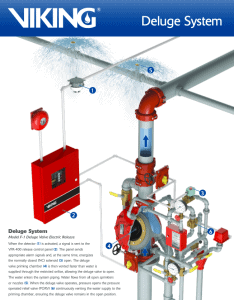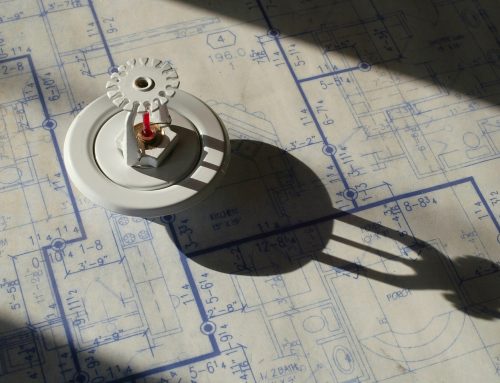 A Deluge Fire Suppression System is a sprinkler system with an empty pipe system, meaning there is no water stored in the piping network. The water is instead stored behind a control valve. A typical Deluge system will have a control valve, a dedicated water supply, and a sprinkler operated detection system.
A Deluge Fire Suppression System is a sprinkler system with an empty pipe system, meaning there is no water stored in the piping network. The water is instead stored behind a control valve. A typical Deluge system will have a control valve, a dedicated water supply, and a sprinkler operated detection system.
A Deluge system is directly connected to a dedicated water supply and when the system is activated, the Deluge Valve releases water to these open sprinkler heads.
These systems are typically used in high-hazard areas where fire may spread rapidly. Unlike traditional wet sprinkler systems, the sprinkler heads on a Deluge system are always left in an open position to allow for large amount of water to be dumped on a hazard. This open position allows water to flow from every single sprinkler head at once versus one at a time.
How is a Deluge System activated?
The sprinkler heads on a Deluge system are fused together and operate as one when activated. The valve is opened when activated by heat or smoke detection systems. Once activated, the water is released into the piping and out of the sprinkler heads.
Since there is no water on the pipe and all the heads are open, a method of release is required for activation.
There are a few ways a Deluge system can be activated. These methods include hydraulic, pneumatic, electric, or manual release and depend on the type of system, which will be explained under the “types” section below. Systems can also use a combination of these methods. The Deluge Valve, however, can only be activated hydraulically.
What is a Deluge Valve?
Per NFPA 25 code 3.5.2, a Deluge Valve is defined as “a water supply control valve intended to be operated by actuation of an automatic detection system that is installed in the same area as the discharge devices.” When the valve is tripped, water flows into the piping system discharging through all spray nozzles or sprinklers at the same time.
Deluge Valves are typically open head systems that have some type of detection line that will release the water at the Deluge Valve so it can be delivered to the nozzles/sprinkler heads on the system for suppression.
What are the types of Deluge systems?
There are several types of Deluge systems. Some are electronically operated so that when an alarm is set off via a detector, pull station, etc., it will energize a solenoid valve releasing the prime water off of the top of the valve and allowing the Deluge Valve to trip and deliver water to the hazard.
Another type of Deluge system would be pneumatic. This type of Deluge system uses a small airline with sprinkler heads on it as the detection line. In the event of a fire, the sprinkler heads on the small detection airline are activated which will deplete the air in the line allowing the pneumatic actuator on the Deluge Valve to open releasing prime water from the top of the valve and allow water to be delivered to the hazard.
Deluge Valves can be installed in a hazard to use foam solution instead of only water. It just depends on the hazard being protected.
What applications should Deluge systems be used for?
Due to the copious amount of water dumped from a Deluge system, they are highly effective in both cooling and extinguishing large-scale fires. Water additives such as low-expansion foam can also be added to these systems for larger hazards that require more coverage area.
These systems are typically found in high hazard applications such as chemical plants, power plants, or wood pulp manufacturing plants.
System size is determined by water supply available to the system and/or the hazard classification.
Importance of water supply
An on-site water-flow test be conducted prior to a Deluge system installation.
Since Deluge systems are hydraulically calculated, the static and residual water-pressure characteristics of the water supply should be obtained by conducting an on-site water-flow test. The fire protection company handling the install will determine if a fire pump is needed.
Other than access to water, another consideration is drainage. A Deluge system produces a large volume of water. Building owners should plan accordingly by ensuring proper drainage and water collection.
Does my building need a Deluge Fire Suppression System?
A licensed fire protection company should be able to answer this question. Choose a fire protection company with experience dealing with Deluge systems. The type of fire suppression system used to protect your building should be chosen based on a number of criteria, namely the size of your building and the hazard it protects.
Fire Systems, Inc. has been in a leader in the fire suppression industry for over three decades. Our expert technicians can advise you on the best system type for your building. We can also design, install, inspect, maintain, and repair all types of fire suppression systems. Find out more information by visiting our website, or give us a call today at 770-333-7979.






